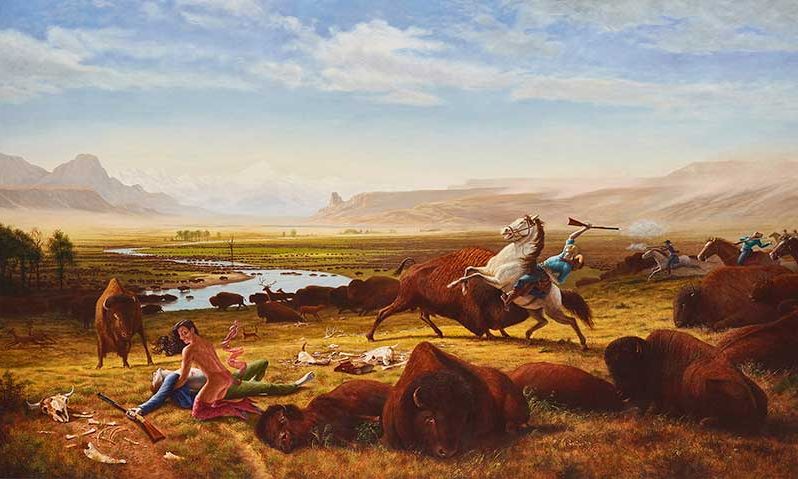Death of Adonis (2009) was one of two paintings by Cree artist Kent Monkman in the Phillips show
© Kent Monkman
Just after ringing in the New Year, Phillips opened the doors of its Park Avenue headquarters for New Terrains, a selling exhibition of work by around 65 contemporary Indigenous artists from the US and Canada across seven decades.
The show (which closed on 23 January) and collectors’ enthusiastic response to it are the latest signals that the market is finally catching up with a recent surge in curatorial interest. Jeffrey Gibson, a Cherokee-descended member of the Mississippi Band of Choctaw Indians, will be the first Indigenous artist to represent the US with a solo show at this year’s Venice Biennale.
In 2023, the Whitney Museum of American Art in New York staged—to rave reviews—the largest survey of work by Jaune Quick-to-See Smith, an 83-year-old citizen of the Confederated Salish and Kootenai Nation. Last September’s Armory Show included a special section curated by Candice Hopkins, a Carcross/Tagish First Nation independent curator, featuring large-scale installations by Indigenous artists from across the Americas.
“It’s extraordinary what’s happening, this tide,” says James Trotta-Bono, a California-based dealer who co-curated New Terrains. “Institutions were very aware that the American art canon was fragmented at best in terms of its narrative, and they’ve been making a very concerted effort to increase the exposure and awareness of Native American artists, both historic and contemporary.”
Trotta-Bono co-curated the exhibition with Bruce Hartman, the executive director and chief curator of the Nerman Museum of Contemporary Art in Overland Park, Kansas, and Tony Abeyta, a Diné (Navajo) artist from New Mexico whose work was included in the show, along with that of his father, Narciso Abeyta. Joining the Abeytas was an increasingly in-demand lineup featuring Gibson, Quick-to-See Smith, Oscar Howe, Kent Monkman, Marie Watt and Teresa Baker.
Phillips opted to offer the works through its private sales department partly because so few of the artists have public auction results, making it sub-optimal to introduce them to the wider marketplace under the hammer, says Scott Nussbaum, Phillips’s deputy chairman and senior international specialist of 20th-century and contemporary art. A private selling exhibition also allowed the pieces to stay on view in Phillips’s New York galleries for considerably longer than the house would typically display auction lots.
“We wanted the show to have a little bit more longevity, and to give people the opportunity to come in to view it without a hurried sense of urgency,” Nussbaum says.
The timing of the exhibition was also significant. January is traditionally the premier month for American art in New York, with the major auction houses peddling stately portraits of founding fathers of the US, pastoral landscapes and domestic interiors—almost all by white artists. New Terrains aims to expand the canon of American art to encompass contemporary Indigenous artists.
Nussbaum says he has never seen a selling show attract greater institutional interest in his more than two decades in the business. While a house spokesperson deemed it too early to share specific placements, they said collectors in both the US and Europe had acquired pieces from the exhibition.
Trotta-Bono thinks one reason the trade for recent Native American and Canadian First Nations art has been “exploding” over the past few years is the Black Lives Matter movement’s amplification of attention on all people of colour working as artists.
“In terms of contemporary art, marginalised artists have a stronger voice now than ever, and I think it was a matter of time,” he says. “Indigenous artists are right there, creating compelling artwork. Their voices have been diminished for reasons that are historically and racially driven. And the current socio-political landscape is ready and excited to champion voices that have been stifled.”
“These artists are talking about the most current issues, and that’s what contemporary arts are all about. I think Native American artists are the avant-garde of America.”

